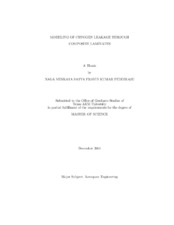| dc.contributor.advisor | Lagoudas, Dimitris C. | |
| dc.creator | Peddiraju, Naga Venkata Satya Pravin Kumar | |
| dc.date.accessioned | 2005-02-17T20:59:02Z | |
| dc.date.available | 2005-02-17T20:59:02Z | |
| dc.date.created | 2004-12 | |
| dc.date.issued | 2005-02-17 | |
| dc.identifier.uri | https://hdl.handle.net/1969.1/1329 | |
| dc.description.abstract | Cryogenic composites find critical application in the manufacture of fuel tanks for reusable launch vehicles due to significant reduction in overall structural weight of the tank. These fuel tanks contain pressurized cryogen such as hydrogen at cryogenic temperatures. Exposure to varying temperatures and mechanical loads resulting from flight cycle, containment of pressurized cryogen causes thermo-mechanical loading of the composite. The thermo-mechanical loading cycles combined with anisotropy of the composite and mismatch in the thermal and mechanical properties of fibers and matrix lead to transverse matrix cracks (TMC) in each ply. TMC in adjacent plies intersect in localized regions at ply interfaces called crack junctions, which open up due to delamination on application of thermo-mechanical load. TMC and crack junctions usually form a network of leakage paths that assists leakage of cryogen through the composite. In this study, the volumetric flow rate of cryogen leaking through a damaged cross-ply composite with five plies is determined by estimating the effective conductance of the leakage paths. For a given damage state and applied load, crack junction and TMC openings are obtained by finite element analysis. A computational fluid dynamics model is first used to estimate the effective conductance of a leakage path to hydrogen leakage and then a simplified analytical model is used to compute the effective conductance from individual conductances of each crack junction and TMC through a series-parallel combination. A single phase flow model is considered for the numerical analysis of hydrogen flow through TMC and crack junctions. The simulations are carried out using a commercial computational fluid dynamics software, FLUENT. Parametric studies are carried out to investigate the dependence of leak rate of hydrogen on the irregularities of the TMC geometry and TMC, crack junction openings. The simplified model predictions of the effective conductance for the five ply composite show good comparison with numerical simulations. | en |
| dc.format.extent | 4675877 bytes | en |
| dc.format.medium | electronic | en |
| dc.format.mimetype | application/pdf | |
| dc.language.iso | en_US | |
| dc.publisher | Texas A&M University | |
| dc.subject | Cryogen | en |
| dc.subject | Leakage | en |
| dc.subject | Cryogenic Composites | en |
| dc.subject | Conductance | en |
| dc.title | Modeling of cryogen leakage through composite laminates | en |
| dc.type | Book | en |
| dc.type | Thesis | en |
| thesis.degree.department | Aerospace Engineering | en |
| thesis.degree.discipline | Aerospace Engineering | en |
| thesis.degree.grantor | Texas A&M University | en |
| thesis.degree.name | Master of Science | en |
| thesis.degree.level | Masters | en |
| dc.contributor.committeeMember | Whitcomb, John D. | |
| dc.contributor.committeeMember | Morgan, Roger | |
| dc.type.genre | Electronic Thesis | en |
| dc.type.material | text | en |
| dc.format.digitalOrigin | born digital | en |


